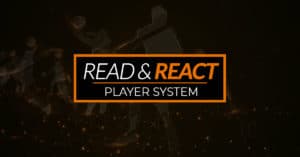Last season Chad Warner completed his second year running the Read & React Offense at Shorter University. The result was a trip to the NAIA Final Four, a record of 34-3, and the NAIA National Coach of the Year Award. In this interview (part 2 of 4), Coach Warner discusses his evolution as a Read & React coach.
In 2011 (year 1 with Read & React), Shorter exited the NAIA tournament early due to a modest upset by an admittedly very good team. That loss forced Chad back into the film room again and again. Ultimately, he came to the conclusion that a large factor in the loss was his team’s lack of rhythm and comfort against a defense that was constantly changing it’s look.
See, Shorter was running Read & React on man-to-man possessions, but not on zone possessions (as many first time R&R coaches tend to do). The problem was that his team was spending so much energy trying to determine what the defense was doing that they weren’t attacking fluidly or effectively. His team had to keep switching gears and could never find its rhythm.
Shortly after that loss, Coach Warner went to see the movie, Moneyball and he knew he had a decision to make. In Moneyball, there’s a scene where the GM and his assistant are at a decision point – jump completely into the new way of building baseball teams or just slowly wade into the change. Obviously, they chose the former and the way baseball teams are built changed forever. Coach Warner saw himself and his staff in that same position – continue to straddle the line or jump completely across. They took the leap.
At the 5:00 mark, Chad recounts the story of his first pre-season practice using the Read & React and how that led to program wide buy-in.
All he asked in that first practice was the first rule of the Read & React: every time a player passes on the perimeter, he must cut to the basket. With just that one rule from Layer 1, the team began to get a lot of easy layups, the defense began to buckle under the constant pressure on the basket, and the amount of movement increased dramatically for a team that already had great movement.
Those three observations were enough. And, the team followed suit.
As his players progressed and became more comfortable with the offense, they began to mold it themselves by finding opportunities to use their strengths within the parameters of the Read & React. Sure, the coaches would tweak and nudge, but it soon became apparent to the players where they could find their best opportunities and attack using their individual strengths. That gave them both freedom to make appropriate decisions at the appropriate time as well as ownership in the style of play. Two characteristics that players love.
Finally, at 9:45 this interview concludes with Chad’s assessment of the tension between the freedom the Read & React offers to players and the controlling nature of many coaches. In the end, Coach Warner was able to balance both of those (and you can too).
Do any of Chad’s insights resonate with you? Let us know in the comments.






